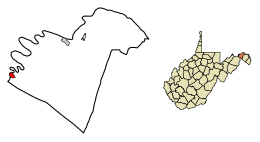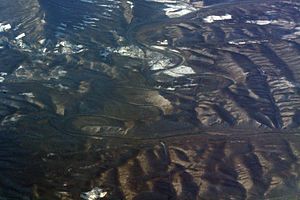Paw Paw, West Virginia facts for kids
Quick facts for kids
Paw Paw, West Virginia
|
|
|---|---|

WV 9 in Paw Paw
|
|

Location of Paw Paw in Morgan County, West Virginia.
|
|
| Country | United States |
| State | West Virginia |
| County | Morgan |
| Area | |
| • Total | 0.53 sq mi (1.37 km2) |
| • Land | 0.53 sq mi (1.37 km2) |
| • Water | 0.00 sq mi (0.00 km2) |
| Elevation | 561 ft (171 m) |
| Population
(2020)
|
|
| • Total | 410 |
| • Density | 928.30/sq mi (358.32/km2) |
| Time zone | UTC-5 (Eastern (EST)) |
| • Summer (DST) | UTC-4 (EDT) |
| ZIP code |
25434
|
| Area code(s) | 304 |
| FIPS code | 54-62332 |
| GNIS feature ID | 2391352 |
Paw Paw is a small town located in Morgan County, West Virginia, United States. In 2020, about 410 people lived there. The town is famous for the nearby Paw Paw Tunnel.
Paw Paw was officially made a town on April 8, 1891. It was named after the pawpaw fruit, which grows a lot in this area. On September 14, 2024, the first Pawpaw Festival was held in the Town Park. Many people came to learn about growing pawpaws and listen to Appalachian music.
The town of Paw Paw is the westernmost community in Morgan County. It is also part of the larger Hagerstown-Martinsburg, MD-WV Metropolitan Statistical Area.
Paw Paw sits along a part of the Potomac River known as the Paw Paw Bends. The Paw Paw Valley is surrounded by mountains like Sideling Hill, Green Ridge, Purslane Mountain, and Town Hill.
While the town's name often makes people think of the Paw Paw Tunnel on the Chesapeake and Ohio Canal, it might actually be named after an older tunnel. This older tunnel was built by the B&O railroad in the 1830s through the Paw Paw Ridge, east of town. The famous canal tunnel, located across the river in Maryland, was started in 1836 and finished in 1850. Today, this tunnel and the canal are part of the Chesapeake and Ohio Canal National Historical Park.
Contents
Town Geography
Paw Paw covers an area of about 1.37 square kilometers (0.53 square miles). All of this area is land, with no large bodies of water inside the town limits.
Paw Paw's Past: A Look at History
Early Settlers and Land Ownership
The first people likely lived in the Potomac River Valley around 10,000 BC. In the 1600s, more and more Europeans started to arrive. As these new settlements grew, Native American tribes were moved from their homes.
In 1681, King Charles II of England gave away large pieces of land in what is now West Virginia. This land, including Morgan County, later belonged to Thomas, sixth Lord Fairfax. In 1746, Thomas Jefferson’s father, Peter, helped survey the area. They found the source of the Potomac River and marked it with the Fairfax Stone.
George Washington and the Paw Paw Bends
The next year, George Washington surveyed this region. He later bought land on the Paw Paw Bends. He described the land as being "In the shape of a horseshoe, the river running almost around it." He noted it had rich soil and many walnut trees.
By 1749, fur traders from the Ohio Company were using the Potomac River near Paw Paw. Settlers also began building farms on the land around the river.
Canals, Railroads, and the Civil War
In 1836, the C&O Canal Company started building a tunnel near Paw Paw. This tunnel was meant to make river travel easier by cutting out seven miles of twists and turns. Two years later, construction began on the Baltimore and Ohio Railroad.
Because of its location near both the railroad and the river, Paw Paw was very important during the American Civil War. About 16,000 Union soldiers stayed there, mostly at Camp Chase (now Camp Hill), east of town.
Local Businesses and Town Life
In 1868, a company from New York opened a leather factory in Paw Paw. This factory gave jobs to hundreds of people until it closed in 1951. Paw Paw also became known for its fruit orchards and places where fruit was packed.
In 1894, a local newspaper said Paw Paw was "more beautiful than in any former time." The streets had good pavements and were lit by oil lamps. In 1926, the town got electricity. The first public school in Paw Paw opened in the early 1870s but was washed away in a flood in 1877.
Historic Buildings and Landmarks
In 1893, two years after the town was officially formed, Paw Paw built its Mayor's Office and Jail. This building was used for town meetings and social events until 1977. It was added to the National Register of Historic Places in 2023.
Other buildings in Paw Paw have also been recognized for their history:
- The former Saint Charles Catholic Mission Church, built in 1876, was added to the National Register in 2024.
- The 1928 Paw Paw Black School, used until 1954, was added in 2024.
- The 1909 WV State Senator P. E. Nixon House, home of a local politician, was added in 2024.
Several other buildings are also considered important historically. These include the 1882 B&O Train Depot, the 1940 Consolidated Orchard Apple Packing Plant, and the 1942 Consolidated Distributors Headquarters, which is now the Paw Paw Town Hall.
How People Get Around: Transportation
The C&O Canal and the B&O Railroad were very important for Paw Paw's growth. The Potomac River was hard to travel on, so a plan was made to build a canal to connect with western settlements.
Building the C&O Canal and Paw Paw Tunnel
The idea for a canal was approved in 1785. George Washington was one of the people who invested in the company. However, the river was still hard to use for much of the year. In 1828, a new company, the C&O Canal Company, took over.
Construction on the Paw Paw Tunnel began in 1836. Workers came from England, Wales, Germany, and Ireland. The project faced many problems like accidents, sickness, worker fights, and money issues. The tunnel finally opened in 1850, much later than planned. It took six million bricks to build the tunnel, which was cut through 3,118 feet of rock using hand tools and gunpowder.
The canal closed in 1925 after a strike in 1922, a flood in 1924, and less demand for coal.
The B&O Railroad's Impact
The B&O Railroad started building after the canal. It reached Cumberland, Maryland, in 1842, eight years before the canal. Railroad construction began in Paw Paw in 1838. Over the next 50 years, Paw Paw became a key place for trade, bringing jobs and wealth to the area.
In 1905, the Western Maryland Railroad was built north of Paw Paw. In 1914, the B&O built a shorter line through Paw Paw, with six stops each day. The main B&O line was removed from Paw Paw in 1961, ending regular passenger train service. The Paw Paw railroad depot, built around 1882, also closed in 1961.
Modern Roads and Connections
In 1928, the first bridge was built over the Potomac River from Paw Paw into Maryland. This allowed a direct road to be completed to Cumberland. Before this, people used a ferry to cross the river.
Today, the main road into Paw Paw is West Virginia Route 9. This road goes east to Berkeley Springs, the county seat. From Berkeley Springs, it connects to U.S. Route 522 and continues east to Martinsburg. To the west, WV 9 crosses the Potomac River into Allegany County, Maryland, where it becomes Maryland Route 51. MD 51 then goes west to Cumberland.
Paw Paw's Population: Demographics
| Historical population | |||
|---|---|---|---|
| Census | Pop. | %± | |
| 1890 | 772 | — | |
| 1900 | 693 | −10.2% | |
| 1910 | 725 | 4.6% | |
| 1920 | 698 | −3.7% | |
| 1930 | 781 | 11.9% | |
| 1940 | 990 | 26.8% | |
| 1950 | 820 | −17.2% | |
| 1960 | 789 | −3.8% | |
| 1970 | 706 | −10.5% | |
| 1980 | 644 | −8.8% | |
| 1990 | 538 | −16.5% | |
| 2000 | 524 | −2.6% | |
| 2010 | 508 | −3.1% | |
| 2020 | 410 | −19.3% | |
| U.S. Decennial Census | |||
In 2010, there were 508 people living in Paw Paw. About 92.9% of the people were White, 2.4% African American, and 2.0% Native American. A small percentage were Asian or from other backgrounds. About 2.6% of the population was Hispanic or Latino.
The average age in Paw Paw in 2010 was 38.6 years old. About 23.6% of residents were under 18, and 16.3% were 65 or older.
Famous People from Paw Paw
- Paul "Oz" Bach, who was a founder and bass player for the music group Spanky and Our Gang, was born in Paw Paw on June 24, 1939.
- The Texas swing band Asleep at the Wheel got its start in Paw Paw, according to its founder Ray Benson.
Images for kids
See also
 In Spanish: Paw Paw (Virginia Occidental) para niños
In Spanish: Paw Paw (Virginia Occidental) para niños






